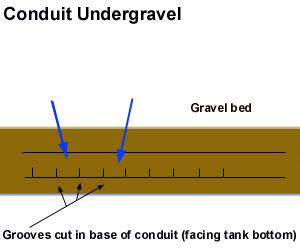by David Midgely
Commerically available “plate-style” undergravel filteration (UGF) rarely receives a “luke-warm” appraisal from experienced fish keepers, hobbyists are divided into those people who like undergravel filtration and those who despise it. “Plate style” UGF in the forward direction (that is, water being sucked downwards through the gravel bed) tends to clog and fail without regular maintanence.
“Conduit” or tubular UGF systems are easy to construct and in my opinion are superior in performance to the traditional plate style of UG filtration. They basically consist of lengths of PVC electrical conduit. Groves are cut 1/3 of the way through the conduit on the side that will face the bottom of the aquarium (Figure at bottom of page), as air moves up the “uplift” tube it displaces water causing a suction which sucks water down beneath the gravel layer. Electrical conduit can be purchased at hardware stores and is easily cut into appropriate lengths (the tubes should be around 15-20cm apart from each other so in a 122cm (4′) tank there should be around 5-6 turns of conduit). “L” connectors can also be bought at a hardware store and the whole UGF is liable to cost around AUD$15-20. A small hole should be drilled at the base of the uplift tube to facilitate entry of the air line (assuming the UGF is air driven, of course). On tanks longer than 90cm it is advisable to either have two air-driven uplift tubes or use a powerhead to power the UGF. The conduit is filled with a smaller amount of water than the volume beneath the plates in the “plate-style” UGF. Therefore the suction along the length of the conduit is increased and a more even “pull down” of water is achieved across the entire base of the tank, which results in a healthier more active biological filter. In the plate style of UGF, suction tends to occur only around the base of the uplift tubes and results in dead areas in the tank and smaller colonies of nitrifying bacteria.
A more effective method of UGF filtration is reverse UGF or rUGF. This involves using a powerhead to pump water down the “uplift” tubes, this results in water moving upwards through the gravel bed. The advantages in this method are twofold. Firstly most powerheads have small sponge “pre-filters” built in, these sponges act as a method for reducing the amount of waste getting trapped in the gravel layer and reducing the beds effeciency. Secondly powerheads pump more water than can be displaced by air movement and therefore create a stronger flow through the gravel bed. Gravel cleans (using a gravel vacuum) must still be undertaken, but in the reverse direction they need not be undertaken as often.
Blue arrows indicate water flow through gravel layer and into grooves.





 This topic is locked
This topic is locked



